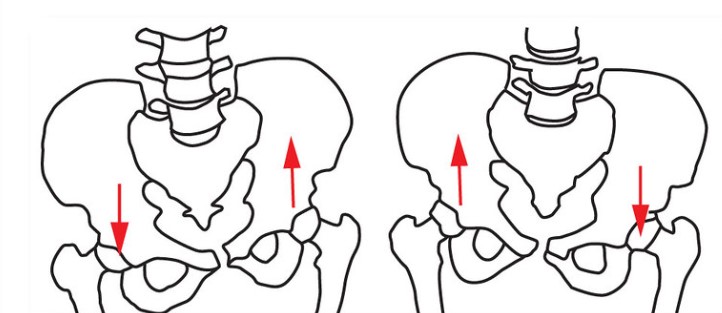How to Fix a Lateral Pelvic Tilt

Are you being bothered by an imbalance when walking? This could be either due to one leg that is longer than the other or one hip that is raised than the other. Both situations affect the pelvic region which is crucial when walking, running, or maintaining good posture.
In normal posture, a pelvic bone should be such that it is parallel to your shoulders and the ground. When one leg is longer or hip is higher, a tilt develops which cause your muscles to get weak and tensed the more you stand, walk, or run.
You are either be born with a lateral pelvic tilt or develop one. The former is hard to fix. While a small imbalance won’t cause many inconveniences, a big imbalance can affect your lifestyle and performance. This is why it is essential to fix your posture.
Fixing hip misalignment or lateral pelvic tilt can be done through corrective exercises such as stretching or self-massage. You can also visit a chiropractor. In this guide, we will look into the different procedures for fixing uneven hips and adjusting the pelvis back to its original position.
Causes of lateral pelvic tilt
Before we delve into the symptoms and treatment procedures, let’s have a look at the causes of hip misalignment. While there are several known causes of the condition, the most common is poor posture, the discrepancy in leg length, and scoliosis.
Poor posture is the most common of the three. It is also the easiest to fix. To understand how it causes a lateral pelvic tilt, it is important to know how your pelvis is structured.
The pelvic region is surrounded by muscles and ligaments whose main work is to stabilize the hip region while allowing for full movement of the legs. When you develop poor posture, the muscles lose their balance by becoming weaker or tighter in some areas.
This eventually leads to a lateral pelvic tilt as the muscles adapt to find a new balance. The tilt is as a result of some muscles raising or tightening on one side and dropping on the other.
Symptoms of hip misalignment
You need a lateral pelvic shift correction if you experience any of the following symptoms:
1. Uneven walk
Making uneven steps is one of the most common indications of lateral pelvic tilt. You will feel like one leg is dropping lower than the other. In some occasions, you will have more difficulty walking on uneven surfaces.
2. Internal rotation of the leg
A lateral pelvic tilt can also be characterized by a situation where your leg rotates internally. While this is one of the symptoms to check out, it may be the cause of the pelvic tilt in some instances.
3. Herniated disc
While not common, this can also be one of the symptoms of hip misalignment. In most cases, it is a secondary effect of disc degeneration.
4. Uneven shoulder lengths
Uneven hips and legs lead to uneven alignment of the shoulders. While this is referred to as “uneven shoulders” that is not really the case. Uneven legs or hips or a tilted pelvis cause you to adopt a sideways slanting position that makes it feel like one shoulder is lower than the other.
How to test hip misalignment
A simple hip imbalance test involves standing in the mirror and holding either side of your hip bone in an akimbo position. If you notice one hand being higher than the other, then your hips could be misaligned.
If you are finding it hard to determine whether the hip bones are straight or not, use a straight object that covers one end of the hip bone to the other. If one end deviates by over 40 degrees, then it could be a lateral pelvic tilt.
Just make sure you are standing on an even surface before you undertake any of these tests. You should also keep in mind that not all cases of an unbalance are caused by a lateral pelvic tilt. One of your legs could just be longer than the other.
Fixing a lateral pelvic tilt
Now that you’ve known the causes and symptoms of a lateral pelvic tilt, how about knowing how to fix the situation? Here are the recommended strategies for straightening uneven pelvic muscles:
Exercises
You can engage in a number of lateral tilt exercises to straighten the pelvis muscles and correct the imbalance. This works for pelvic tilt injuries caused by bad posture.
Try any of the following exercises to adjust the pelvic and improve your mobility:
-
Reverse leg raises
Lie flat facing down and raise one leg gradually while keeping the knees straight. Hold up the leg for 2-5 seconds without lifting the other knee or arching your back. Repeat about 10-15 times before you switch to the other leg.
-
Glute Medius stretch
Lie on your side with the bottom leg bent at the hip and knee while the upper leg should be straight and lifted slightly. Do this 15-20 times or until you feel fatigued before switching to the other leg.
-
Hip adductor strengthening
This exercise helps to improve hip mobility and it comes in handy where stretching doesn’t work. To do this exercise, lie on your side with your head slightly raised and tour upper leg across the body such that it steps in front of you while the lower leg remains straight.
Place a slight weight at the ankle on the lower leg and try lifting it slightly. Do that until you are exhausted before you switch to the next leg.
-
Hip realignment
Lie on your back with your feet up against a wall. Press one leg to the wall and lift the other backwards towards your body slightly. You can use your hands to press the other leg on the wall to prevent it from moving. Make the motions with the other leg for about 15 seconds before you switch. Do this exercise until you are fatigued.
Chiropractic care
A chiropractor can help with sciatica as well as a realignment of the hips and pelvic region.
Chiropractic treatment involves adjustment, physical therapy, massage therapy, and stretching, among others. A chiropractor will determine the right method based on the extent of your pelvic tilt.
Massage therapy
A massage therapist will use a number of techniques to strengthen your muscles and improve mobility. These exercises also help to alleviate the discomfort that is associated with hip misalignment.
Keep working for that posture
If you have developed an uneven waist, we hope the above guide has been helpful to help you bring your hip back into alignment without the need for surgery. While a pelvic tilt is uncomfortable, the good news is that with the right exercises and treatment processes, you can rectify the condition and prevent it from happening again.

![Good Posture When You Draw [How to Get the Best Position]](https://www.goodposturehq.com/wp-content/uploads/thumbs_dir/Good-Posture-When-You-Draw-prlnpziekmihpj280qk0337a867a3d3oaq0qc83nbo.jpeg)
![SUV vs Sedan Good Driving Posture [Best Sitting Position]](https://www.goodposturehq.com/wp-content/uploads/thumbs_dir/Sedan-Good-Driving-Posture-prgr0xfu7wpe98up4mvnrs2g311miv57eesvnlpdck.jpeg)


